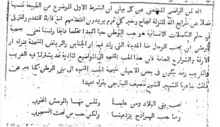 Issue 173 of the paper dated August 1861 | |
| Type | Weekly newspaper |
|---|---|
| Owner(s) | Khalil al-Khuri |
| Founder(s) | Khalil al-Khuri |
| Publisher | al-Matba'a s-Suriyya |
| Editor-in-chief | Khalil al-Khuri |
| Founded | 29 June 1858 |
| Language |
|
| Ceased publication | 10 April 1911 |
| Headquarters | Beirut |
| Country | Lebanon |
| OCLC number | 213490831 |
Hadiqat al-Akhbar (Arabic: حديقة الأخبار, lit. 'The News Garden' ALA-LC: Ḥadīqat al-Akhbār) was a weekly newspaper which was published in Beirut in the period 1858–1911 with a two-year interruption. Its subtitle was Ṣaḥīfat Sūriyya wa-Lubnān (Arabic: Newspaper of Syria and Lebanon).[1] The paper was the first private daily in Beirut,[2] the first Arabic newspaper which had a regular literary section[3] and the first weekly Arabic newspaper in the region.[4]
History and profile
Hadiqat al-Akhbar was launched by Khalil al-Khuri, a Syrian, in Beirut.[5][6] The first issue appeared on 29 June 1858.[7] Michel Médawar who was a Greek Catholic merchant working at the French Consulate in Beirut as an interpreter financed the paper.[5] Khalil Sarkis who would start his own title Lisan al Hal in Beirut in 1877 worked for the paper.[8] Its publisher was al-Matba' as-Suriyya which was owned by al-Khuri.[9] He also edited the paper which began to be published both in Arabic and French from 1870.[7][10] The French edition was entitled Hadikat-el-Akhbar. Journal de Syrie et Liban.[3]
Hadiqat al-Akhbar was made a semi-official publication of the Ottoman Empire in 1860 upon the request of Fuad Pasha, Ottoman foreign minister, in the aftermath of the civil conflict in Mount Lebanon and Damascus.[11] Its semi-official status continued until the official Ottoman publication Suriya was launched.[11] Hadiqat al-Akhbar also functioned in this status between 1869 and 1870 during the governorship of Franco Pasha in Lebanon.[11] The paper was also supported by the Egyptian Khedive Ismail Pasha, possibly after the Ottoman support ended.[12]
The contributors of the paper and al-Khuri were members of the Médawar Literary Circle.[5] Selim Nauphal was the editor who translated and serialized the French novels in the paper.[5] Antonius Ameuney was the contributor of the paper based in London.[5]
During its lifetime the frequency of Hadiqat al-Akhbar was changed from daily to weekly and then to biweekly.[13] It featured local and international news, reports on mercantile activity and also literary works.[5][14] Soon after its start the paper became one of the leading publications in Beirut.[9] Hadiqat al-Akhbar was also distributed to other cities, including Damascus, Aleppo, Baghdad, Alexandria, Cairo, Istanbul, Paris, London and Leipzig.[5] The number of subscribers was nearly 400 within the three months after its start.[5] It gradually increased over time.[5]
In 1907 Hadiqat al-Akhbar temporarily ceased publication.[7] Its publication was restarted in April 1909, but the paper was permanently closed down on 10 April 1911.[7]
References
- ↑ Ḥadīqat al-akhbār. WorldCat. OCLC 213490831. Retrieved 5 February 2022.
- ↑ Marwan M. Kraidy (1999). "State Control of Television News in 1990s Lebanon". Annenberg School for Communication. 76 (3): 486. doi:10.1177/107769909907600306. S2CID 144387260.
- 1 2 Johann Strauss (2003). "Who Read What in the Ottoman Empire (19th-20th centuries)?". Middle Eastern Literatures. 6 (1): 43. doi:10.1080/14752620306881. S2CID 162158665.
- ↑ Fawwaz Traboulsi (2012). A History of Modern Lebanon (2nd ed.). London: Pluto Press. p. 61. doi:10.2307/j.ctt183p4f5. ISBN 9780745332741. JSTOR j.ctt183p4f5.
- 1 2 3 4 5 6 7 8 9 Anthony Edwards (2020). "Serializing protestantism: the missionary Miscellany and the Arabic press in 1850s Beirut". British Journal of Middle Eastern Studies. 49: 2, 14–18. doi:10.1080/13530194.2020.1765141. S2CID 219498842.
- ↑ Aida Ali Najjar (1975). The Arabic Press and Nationalism in Palestine, 1920-1948 (PhD thesis). Syracuse University. p. 23. ISBN 9781083851468. ProQuest 288060869.
- 1 2 3 4 "Archive". Leibniz Zentrum Moderner Orient. Archived from the original on 24 May 2021. Retrieved 5 February 2022.
- ↑ Jens Hanssen; Hicham Safieddine (2019). "Butrus al-Bustani: From Protestant Convert to Ottoman Patriot and Arab Reformer". The Clarion of Syria. A Patriot's Call against the Civil War of 1860. Berkeley, CA: University of California Press. p. 24. doi:10.1515/9780520971158-005. ISBN 9780520971158.
- 1 2 Ami Ayalon (2008). "Private Publishing in the Nahda". International Journal of Middle East Studies. 40 (4): 561–577. doi:10.1017/S002074380808149X. S2CID 162416226.
- ↑ "A Chronology of Arabic Periodicals". Project Jara'id. Retrieved 28 April 2023.
- 1 2 3 Caesar A. Farah (2010). Arabs and Ottomans. Piscataway, NJ: Gorgias Press. p. 52. doi:10.31826/9781463225445-007. ISBN 9781617190896.
- ↑ Adam Mestyan (2014). "Arabic theater in early khedivial culture, 1868-72: James Sanua revisited". International Journal of Middle East Studies. 46 (1): 119. doi:10.1017/S0020743813001311. hdl:10161/12572. S2CID 162781557.
- ↑ Fruma Zachs; Sharon Halevi (November 2009). "From Difāʿ Al-Nisāʾ to Masʾalat Al-Nisāʾ in Greater Syria: Readers and Writers Debate Women and Their Rights, 1858-1900". International Journal of Middle East Studies. 41 (4): 617. doi:10.1017/S0020743809990390. S2CID 232252692.
- ↑ Lawrence Pintak (2019). "Middle Eastern and North African Journalism". In Tim P. Vos; Folker Hanusch (eds.). The International Encyclopedia of Journalism Studies. Wiley-Blackwell. p. 1. doi:10.1002/9781118841570.iejs0173. ISBN 9781118841570. S2CID 155248874.
External links
 Media related to Hadiqat al-Akhbar at Wikimedia Commons
Media related to Hadiqat al-Akhbar at Wikimedia Commons